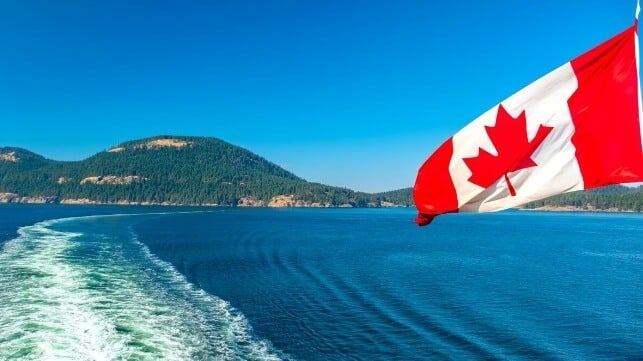Op-Ed: As Tariffs Rise, Canadian Cruisers Can Skip the U.S. Market

The Canadian public has responded to the American tariff on trade. Airline bookings from Canada to American destinations has dropped by an estimated 70%. Many Canadians who had earlier booked passage aboard cruise vessels sailing from American ports or sailing to American destinations - such as Juneau, Alaska or Hawaii - have cancelled their planned trips.
Introduction
America’s trade tariffs have had an impact on the Canadian public, with layoffs expected in multiple sectors across the Canadian economy. A large number of Canadians who had earlier planned to visit the United States as tourists have canceled their plans. Airline operators and cruise ship companies that operate to and from American locations have experienced a decline in customers from Canada, most of whom are planning to travel domestically. Canadian-owned and Canadian-registered cruise vessel operators who sail to and from Canadian locations have experienced an increase in bookings.
Cruise ships sailing from Europe and the UK to the North American Great Lakes have attracted an increasing number of customers over the last several years. The recent imposition of American tariffs on European and British products has potential to affect European and British tourism to North American destinations. Cruise ships sailing between the North Atlantic and Lake Ontario need to transit through American navigation locks located on the Upper St. Lawrence River, where American border patrol officials have the authority to check documents. Cruise ship operators have the option to arrange to have tourists bypass the American navigation locks.
Bypassing the Locks
A dock capable of berthing Seawaymax size cruise ships is located at the former Port of Cornwall, which might need to be reactivated for the cruise industry. Cruise companies that sail vessels from Toronto and Kingston to locations that include Ottawa, Montreal, Quebec City and ocean coastal locations, might consider sailing from Port of Cornwall. Likewise, cruise ship operators that sail from Europe and Britain to the Great Lakes also have the option of sailing to the Port of Cornwall, to transfer their guests to motor coaches for transportation to Port of Johnstown.
Despite the Port of Johnstown being a bulk freight terminal, passenger cruise vessels have stopped there to transfer passengers to tour buses that carried tourists to and from nearby tourist attractions. There is potential for cruise vessel operators to keep a few vessels on the Canadian side of the Great Lakes, to sail from Port of Johnstown to Georgian Bay, via Lakes Ontario, Erie and Huron with stopovers at Kingston, Toronto and Niagara Falls region.
Canadian Cruising
A 120-feet length mini cruise vessel dubbed Kawartha Voyageur has clearance to sail from Kingston at the northeast corner of Lake Ontario, through the navigation locks of the Rideau Canal that connects to Ottawa, with additional clearance to sail the Ottawa River to Montreal. The vessel does on occasion sail to Quebec City. A slightly larger vessel with 35 cabins, dubbed Canadian Empress, is cleared to sail the Ottawa River between Montreal and Ottawa. It regularly sails along the St. Lawrence River between Montreal and Quebec City.
While the dimensions of Canadian Empress are slightly smaller than the navigation locks along the Rideau Canal, it usually sails along the Upper St. Lawrence River from Kingston to Montreal and the Ottawa river to and from Ottawa. Due to the imposition of American tariffs and a crackdown on foreign nationals in the USA, the operator has the option to divert guests around American customs at the navigation lock. The vessel is able to berth at Canadian marinas located on both sides of the navigation lock, potentially allowing guests to travel a short distance by bus between marinas.
Western and Northern Cruises
Several Vancouver–area companies that own small cruise vessels offer the equivalent of river cruises by sailing the Inside Passage from Vancouver and into scenic inlets that connect to the Strait of Georgia. While not a tourist ship, a Canadian passenger ferry service sails the scenic route from Vancouver to small communities located along Canada’s Pacific coast. Canadian small – cruise vessel companies that sail from the Port of Vancouver aim their services at a different market than mega-scale cruise vessels.
The small vessels carry anywhere from 6 to over 50 guests and offer a very different itinerary to mega-scale vessels, which are unable to turn around within the limited width of the scenic inlets. Unlike cruise ships that make brief stopovers, the small vessels make extended duration stops at small coastal villages, to the delight of many of their guests. Summertime Arctic cruises are becoming popular. One multiday Arctic cruise sails from Port of Churchill on Hudson Bay with ports of call extending to Western Greenland. It interconnects with a passenger train from Winnipeg.
Conclusions
American tariffs have elicited a response from Canadian citizens who previously flocked to American tourist destinations and boarded cruise vessels at American ports. Tariffs have begun to hit the tourist industry. Canadians - along with guests from numerous overseas origins - are becoming selective when booking passage aboard cruise vessels.
